Ni no Kuni: Holding Games to A Higher Standard of Writing
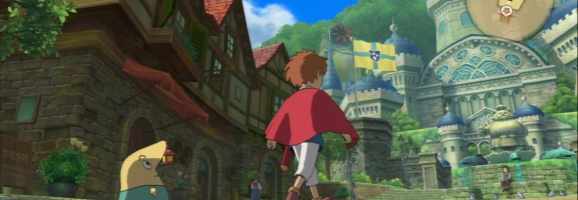
I recently had the pleasure of playing through Level-5 and Studio Ghibli’s role-playing epic Ni no Kuni: Wrath of the White Witch (2013). While the gameplay was solid and enticing (for the most part), the visuals gorgeous, the music slightly above average, the game’s narrative felt loose, like it lacked a certain, sorely missed complexity.
Ni no Kuni lacked a sense of tension, and had too many lulls to keep its narrative afloat. Saying it’s a kids game, or a game in general, isn’t really a satisfactory answer. While I truly did enjoy the experience, by the end of it, I no longer was even paying attention to the plot and exposition.
Comparing video games to cinema is inevitable and useful. Both are total works of art (the Wagnerian gesamtkunstwerk, which I inevitably always bring up, the all-encompassing artwork), combining visual art, music, and literature to give a unique experience to the audience.
Where the two mediums part is that film is a passive art, one the audience watches but rarely participates in (there are exceptions), whereas games are interactive to varying degrees. These degrees of interactivity are important when considering game narratives, but that’s a discussion for another time.
Some video games are narrative-heavy, games with plots as dense as Xenogears (1998) and as thin as Ocarina of Time (1998), games where the story and characters, one of which is most likely the player’s avatar, push the game’s narrative forward. Ni no Kuni falls under this category, as do most modern Japanese role-playing games.
Many games are not narrative-heavy, allowing the “gameplay” to override the game’s narrative’s importance and push the narrative forward. These range from games like block puzzler Tetris (1984) to Super Mario Bros. (1985) to recent mobile game Flappy Bird (2013). Players do not play as Mario to save Princess Toadstool, they play for the adventure and for the action-platforming content. Saving an 8-bit princess may be a nice incentive to win, but it adds little to the understanding of the characters and plot, or the tone or mood.
There are also narrative-heavy games with open-world environments, such as the Elder Scrolls series and the Grand Theft Auto games, which are structurally very different, allowing players to follow the game’s set narrative or explore their own. This genre of story-telling is also important when considering game narratives, but does not pertain here.
There has been a contemporary push to hold video games to a higher standard of writing for narrative-heavy games. While it may seem unfair, or even controversial, to compare the writing of Final Fantasy XIII (2010) to a film, for instance, Her (2013), because they are totally “different mediums,” video games and movies share many similarities in terms of plotting and characters.
Both typically feature a closed-off narrative, a whole, complete story arc. Games are much longer than films, some over fifty hours, because of the gameplay that “pads” the narrative, but most games can be broken into the three-act structure of cinema. Ni no Kuni is a game that absolutely takes its story-telling cues from the three-act structure of screenwriting, and it is easy to pick out where acts end and begin.
A quick explanation: the three-act structure is a system in story-telling (and in particular screenwriting) that divides a narrative into three parts or acts. The first act is reserved for introducing the main characters and the inciting incident, which starts off what the narrative is “about.”
The second act is often noted as the “rising action,” where the protagonist attempts to deal with the problem caused by the inciting incident. Audiences see characters grow and learn from their mistakes, and the end of the second act typically ends on a point of high tension. The third act features the resolution of the problem, the climax, and often, a denouement, a brief return to normalcy.
This three-act structure is easily applied to both The Godfather (1972) and Ocarina of Time, Ocarina being particularly cinematic, and even larger, more unruly narratives, like Pulp Fiction (1994) or Final Fantasy XII (2006). The structure is not meant to limit narratives. It is a way to understand how a story operates and how it compels audiences to continue paying attention.
Holding video game writing to a high standard is important. Games are a relatively new story-telling medium and the possibilities of the kinds of stories told in games is nearly unlimited. In this way, games have an edge over film, at least in terms of experimentation.
Games can string players along for dozens of hours (in the case of Ni no Kuni, at least forty), exploring a variety of tones and aesthetics, differing cultures and environments. When playing a narrative-heavy game, players enter a contract with the game, that the game will offer entertainment in the form of gameplay and narrative, and in return, the player must beat the game, however many hours this will take.
My aim is to apply the three-act structure to Ni no Kuni to pick out the narrative’s strengths and weaknesses in order to ultimately decide if the narrative is a strong one. I will try to recount the plot of the game as clearly and decisively as possible, so heavy spoilers will follow:
The first act of a film begins with a “hook,” something that entices the audience to explore the piece further. For Ni no Kuni, young protagonist Oliver’s mother dies from a heart attack. Oliver then meets Drippy, a little animate stuffed animal that acts as Oliver’s mentor, who promises that Oliver can revive his mother if Oliver travels to Drippy’s magical world with him.
Oliver’s mother’s death also acts as an “inciting incident,” which sets the course of the plot in motion.
The duo travels to Drippy’s world, the world of the game, which is much more fantastic than Oliver’s home, Motorville, which closely mirrors reality. Drippy explains that there is a great evil force in the world, an evil shaman named Shadar, and that the two must somehow defeat him. Drippy also explains that everyone from Motorville has a soulmate in his world, and that each pair of soulmates has a magical bond.
The “defining action” for Oliver is that he agrees to help Drippy and the two travel to Old Father Oak, an old wise tree, for advice. The plot picks up here, and the player gets a taste of Drippy’s world and some backstory exposition.
The “point of attack,” which refers to when the protagonist’s story gets into full motion, is when the film feels like it’s truly started. This occurs when Oliver is ready to leave Ding Dong Dell, the first major city in the game, to embark on his quest. Oliver knows he needs to seek the guidance of the Sages in order to have a chance of defeating Shadar, and this is the first time Oliver will travel a great distance on the game’s expansive world map.
Oliver reaches Al Mamoon, the oasis hub city, home of the Great Sage Rashaad, who serves as a “mentor” for Oliver. It is important in the first act for a mentor to lead the protagonist in the right direction, whether it is Drippy and Rashaad for Oliver, Obi-Wan Kenobi for Luke, or even Randal for Dante in Clerks (1994).
Rashaad’s daughter, Esther, joins Oliver on his quest after he is done in Al Mamoon, which serves as the end of the first act. The protagonist’s quest is clearly defined (find the other sages and defeat Shadar), and Oliver, Esther, and Drippy now have a set course, find the Sage in Hamelin, a mysterious city on a far away continent.
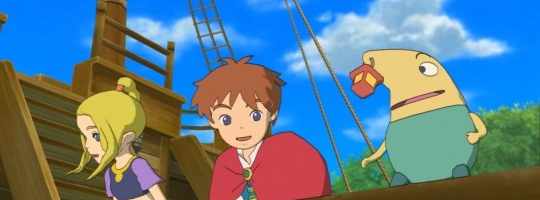
Interestingly, Esther’s addition to Oliver’s party provides as much of a gameplay shift as it does a narrative one. Games that combine gameplay and narrative shifts seamlessly usually are better for it, the most perfect example being the stunning Majora’s Mask (2000) for the Nintendo 64.
With Esther in the party, Oliver can now catch “Familiars,” similar to other monster catching games, and the player’s bond and understanding with the game world increases, and his battle tactics change. The gameplay becomes far more complex.
The second act begins with an “enter the new world” beat, which is clearly marked in Ni no Kuni by the acquisition of a boat for Oliver’s party, which opens up the game’s oceans and continents to explore. This again ties the narrative shift with a gameplay one, and many Japanese role-playing games use a new means of locomotion to mark a major narrative shift.
This may be an easy solution to mark such a large shift, but it is an effective one. The game’s tone has a subtle shift, and players are made to feel much smaller.
The second act also houses the “b-plot,” which usually, both in films and in games, is a romantic interest, but here, it is the story of Swaine, a swashbuckling bum with a mysterious past. While the “b-plot” usually involves character growth, most of the tracking of it through the second act involves information being fed to the player about Swaine’s past, which isn’t particularly interesting. That being said, there is something of a character shift for Swaine, who begins scrappy but ends somewhat nobler.
Whereas many Japanese role-playing games feature huge casts of intricately plotted characters with unique backstories, Ni no Kuni suffers from a lack of sub-plots. Esther, who is one of the secondary protagonists, gets shafted here, as she never develops as a character after joining Oliver. She is a character without wants or needs, and merely serves to bolster Oliver’s wants and needs, which is a true missed opportunity to tell a better, more lively story.
The writers were wise to not include a romantic sub-plot between Oliver and Esther, which would make no sense, but their bond as symbolic older sister/younger brother should have been further explored, as it would have made her character more complex.
A “first attempt fails” beat usually follows closely after the start of the second act, and here, it is when Oliver, Esther, and Swaine do battle with Shadar for the first time on the ocean. While Oliver and crew fend off Shadar (unless the player loses the fight), Shadar escapes unscathed and still at large.
A set of “new rules” is established, and many thematic and dramatic questions are posed. Why did Shadar let Oliver live? What are his ultimate motives? In less narrative-heavy role-playing games, most antagonists are simply evil, seeking world domination or absolute ruin, but Shadar’s character is written with more depth and mystery, distinguishing Shadar from a simply “evil” antagonist.
Much of the second act is about “getting the most out of the genre.” What this means is in action films, for instance, the second act features several car chases, gunfights, and sharp dialogue. In a comedy, the second act features a good deal of laughs, and in an adventure, the second act has the protagonists visiting many exotic locations. Games are no different.
In most narrative-heavy games, most of the time is spent primarily in the second act. A typical film lasts two hours, and is usually divided into a half hour first act, an hour second act, and around another half an hour for the third act. A role-playing video game could have a two hour first act, a forty hour second act, and an hour third act.
For Ni no Kuni, the second act is full of exploration, quests, caves, dungeons, traveling via boat and eventually dragon. Players are encouraged to explore and experiment with different party combinations in battle, and players who enjoy Japanese role-playing elements will enjoy discovering new equipment to use and learning new skills for battle.
Typically, near the middle of the film/game/adventure, is the “midpoint,” which hints at the ending of the narrative through a major character shift. For Star Wars, the “midpoint” is when the Millennium Falcon is taken into the Death Star, for Cast Away, it is the four years later mark, The Godfather, when Michael guns down Sollozzo and McClusky in the Italian restaurant. This point is meant to renew the audience’s interest in the narrative, a sort of pre-climax climax.
In Ni no Kuni, Oliver’s character shifts when he learns the truth about his mother, that she was one of the Sages and thus cannot be revived as she has no otherworldly soulmate. This was Oliver’s goal on his adventure, to save his mother, but the quest is no longer just about him. The fate of Drippy’s world now rests on his shoulders, and Oliver must help his new friends defeat Shadar regardless.
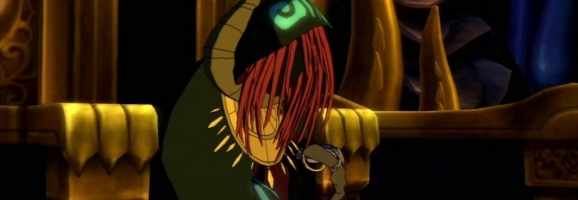
This shows a big departure from the reluctant crybaby Oliver from the beginning of the game. The protagonist has really matured, much as Luke does in Star Wars. The audience and Oliver are also told that Oliver may be Shadar’s soulmate, which means if defeated, Oliver may also lose his life. Oliver continues despite this new tension.
The end of Ni no Kuni‘s act two is shaky. It is unclear whether or not Shadar is the final antagonist, and the game hints that there is a greater evil lurking elsewhere. The end of act two is when Oliver and crew reach Shadar’s stronghold and confront him. The audience gets some backstory, learns that Shadar is not truly evil, and that he is indeed Oliver’s soulmate.
Oliver tells his friends to fight anyway, and they do, defeating Shadar. This could be the end of the game, though, structurally, it feels like it is the end of act two. The tension built from the entire game is released when Shadar is defeated, victory music plays, and Oliver and crew return home, safe and sound.
This calm, victorious beat acts as a denouement and the game feels over.
However, this is not what happens. As Oliver plans to return to his world, the White Witch, the true antagonist, uses her magic to turn the people of the world into zombies. This is a “new goal” type of end for act two, which is not uncommon, but it is quite jarring here.
The stakes are certainly raised, and the new goal defined, but there was no prior build up to this event, and thus, it feels “tacked on.” A bit of history: Ni no Kuni is based on a Japanese Nintendo DS game, and in the original version, the game does end after the defeat of Shadar. So, it literally was “tacked on,” but this is no excuse for shoddy plotting.
Players do get to see mysterious glimpses of the White Witch throughout the game, but it is simply too late to introduce this major plot shift so suddenly. Using Star Wars again, the end of act two is when Obi-Wan dies during his duel with Vadar. Tension rises, not falls, as when Shadar is defeated, and Luke must now put everything he has into destroying the Death Star.
Players feel cheated, as the game practically explicitly tells them they are finished. There’s no “I knew it!” moment, no major reveal when the White Witch comes forth. It just doesn’t make sense.
As a writer, it is difficult to gauge how audiences will react to twists and surprises. Maybe the addition of the White Witch makes the game feel more whole, and certainly more surprising. It adds a sense of mystery to the game’s world. Yet, that major lull in tension after the defeat of Shadar is too great to ignore, and it would not be surprising if players did not have the energy or motivation to continue playing.
The third act is marked by a “big gloom,” which here is Oliver witnessing the world’s population turning into bloodthirsty zombies. There’s a tonal shift here into a much darker world, which may or may not fit into the bright, generally cheerful established world.
The zombie infestation acts as a “ticking clock” as well, but it is a weak one, as Oliver quickly quells the zombies and returns the world to normal long before facing the White Witch. A ticking clock is important for keeping the tension raised at the end of the second act and building it up toward the final climax. For the world being filled with zombies, there really isn’t much tension built.
There is a “convergence” of characters as everyone Oliver has met along his journey prepares together to charge the White Witch’s floating tower. This is nice as it does remind players of their past victories, as well as reinforce the idea that the player has actually affected the fictional world. Each named NPC appears on the main airship and the different world leaders send in their troops, which ends up being anticlimactic, as no evidence is given to what ever happens to these troops. When Oliver enters the tower, there is no sign of battle.
The “final battle” involves Oliver and company storming the White Witch’s tower, and facing her in battle. There is a “resurrection/sacrifice” beat as the White Witch gives Oliver and the player some direct exposition on her depressing backstory and history with Shadar. The player can sympathize here with the White Witch, but there’s not enough weight to her story and her existence in the game to make her cutscene a tearjerker.
The “magic flight,” “execution of a new plan,” or “final push” is when it is revealed that the White Witch was being controlled by a council of ancient, ethereal politicians, who serve as the true final battle.
Again, this has been hinted at before, sporadically, but there’s too little too late to have an emotional impact on the player. We’ve long forgotten the fight against Shadar, and are barely paying attention to the direct exposition from the White Witch, so these evil, immortal councilmen, the supposed pinnacle of the narrative, just have such little impact.
Xenogears, a Square Japanese role-playing game for the original PlayStation, features a similar plot of ancient, evil, immortal councilmen calling the shots, but the mystery is strung alone at a slow but thorough pace, catching the player’s attention by the time the big reveals happen. By the end of the second act in that game, players’ heads are exploding with mysterious tension and really feel compelled to continue.
Then the final denouement, the “return with the elixir,” as players see Oliver’s troubles truly solved and the world saved. Oliver’s mother’s revivification was one of his wants that propelled him forward, but his need, his need of friendship and support, has been fulfilled by the end. While Swaine, Esther, and Drippy, and the game’s world have irrelevant endings, at least Oliver has a major character arc and shift, which is satisfying for the player, the audience.
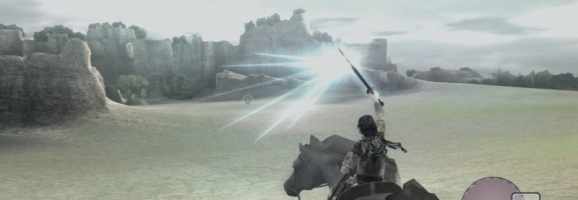
So, why hold a video game to this high standard of writing? Games are supposed to thrive on gameplay, and narrative is just a secondary element, just like music, right? Players cite “story” or “plot” as what they find interesting about role-playing games, but the RPG elements are the meat of the game experience, the systems, the collecting, the adventuring. If the exact dialogue of any given Japanese role-playing game was published in book form, wouldn’t it be an awful, or at least incomplete book?
But video games are not just games, at least not just games to be toppled and won. Even the simplest game narratives are exercises in creativity, visual, literary, that capture the attentions and imaginations of players and audiences. Video games that focus on tone, both through text, image, and gameplay, through lighting and dialogue, games that have a distinct aesthetic that runs through their gameplay, narrative, visuals, and sound, are the ones that are remembered and revered.
A video game’s narrative should be satisfying, no matter how minimal, and compelling, and expertly executed. Shadow of the Colossus (2005) is nearly silent, and Monster Party (1989) is a series of absurdist, non sequitur 8-bit puns, but both are loved and remembered for their distinct narratives. For larger, more narrative-heavy video games that function more like a film, the pacing of both successful games and films should be studied and emulated. This is how art grows.
Ni no Kuni‘s ending is not disappointing, merely lackluster and forgettable. While it has the makings of an RPG epic, with a cast of colorful characters, the plotting just doesn’t hold a lot of interest. There are pages and pages of dialogue, some of which is entertaining, funny or heartfelt, but the narrative as a whole is unsatisfying.
There are countless famous game composers, artists, and directors, but few beloved game writers. With the rise of independently published video games, more and more game creators are telling personal or unique narratives through the medium, which is a promising step as a new wave of game “auteurs” are making names for themselves.
The future of video game narratives will be an exciting one, certainly.
What do you think? Leave a comment.
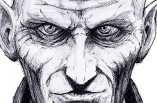
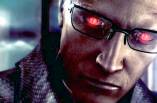

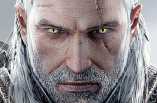
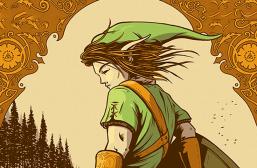
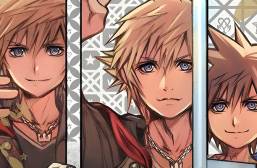

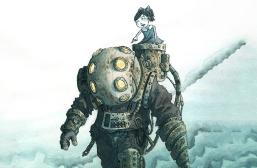



I’ve enjoyed Studio Ghibli’s animes in the past and this seems to be a fantastic mix. Unfortunately I’m really not a fan of console exclusives. I feel I shouldn’t have to be pigeonholed into a specific console to play a great game. Especially, when the reason for the exclusivity has nothing to do with another consoles lack of capabilities. This game should be available to all of the gaming community regardless of console.
Amazing game. Spent about 42 hours playing it and just recently finished the story. I’ve been humming the music in my sleep. It really is an engrossing world you can explore. There are so many little sidequests for you to do and they are actually very rewarding when you complete them. As I write this I still have about 15 missions and 10 more bounty hunts to complete. I better get to it.
Good luck! I was so exhausted by the end. The final quests are real killers. There are tricks, though, which I’d recommend you look up online ; )
The story was compelling, a little boy out to save his mother by traveling to another dimension and rescuing the alternate reality version of his mother was refreshing. However I never really felt pulled into the character stories more then the surface. Oliver’s voice acting was as put by, many bland and monotone compared to the rest, which was disappointing being he is the main character.
I was surprised at how weak Oliver’s voice was considering that Level 5 are such great localizers.
While gameplay is important, I hold story to at least as high a standard when deciding which game’s to play. With recent games like The Last of Us, Journey, The Walking Dead and others I think the industry is moving in the right direction, especially given those games success. I didn’t find Ni No Kuni’s story particularly captivating, but I’ll admit it had a nice style and unique feel about it for a video game. And Shadow of the Colossus, I could talk forever about that game!
I think Dragon Quest VIII does everything Ni no Kuni does but much better and meatier. While it has less of a cinematic plot, its world and exploration is spot-on. I also think Akira Toriyama’s designs are more charming than Ghibli’s, surprisingly.
Let us not forget Ico, the game that you literally feel like you are the character. You are supposed to save a princess that you pull along by the hand, and you can literally feel her tug on the controller. This was the game before Shadow of the Colossus, and really this game gave you no choice but to feel emotionally connected. There is a point where the princess is taken, and then her slight tugging on the controller is gone. You literally feel her loss.
It is decisions like that, combining the physical and the emotional together, that is an area that games should not ignore in their making, however, I have not seen any that have thought about that kind of element since.
I can say that there are many different reasons people play games in the first place, but unfortunately the whole story line is still not something easy to grasp. It is really what happened in the beginning of movies, when film makers used scenes like theater, and people could only come in from the sides. All the rules of movies only developed after a long time, and the shift of people actually paying attention to writing good stories might happen only if people who are experimental and independent game makers get funding. Just like blockbuster films, when too many people are making decisions, you get a bad story. I can just imagine the board of councilmen now… 😉
Thanks for writing this! I was considering using Ico as my example, but chose Shadow over it because I knew it would resonate with more readers. I prefer Ico to Shadow, definitely, as it’s the more charming of the two, though both are hugely solid.
Insightful review and look into the game. I’ve seen a few of the movies, so I guess now I’ll just have to try the game out for myself. Well done!
It was a beautiful game…. It felt like being in a studio ghibli film and they should have gotten way more credit for this game than they did. Their name wasn’t even on the box!!!
Unfortunately I felt the battle mechanic was terrible. The AI was basically broken and I played the whole game including all bosses with the tactics set to ‘don’t use abilities’ otherwise the AI made unsound battle decisions. The fetch quest nature of the errands to give hearts etc was plain tedious and very childish. Also this is a very easy game and i feel it is more suitable for children than adults.
I wouldn’t consider this game geared toward children – it’s a fantasy JRPG, through and through. It just looks cartoony, like Wind Waker.
The AI is definitely awful, but with the right Familiar setup, the team can be extremely useful.
I truly don’t feel like this game feels like being in a Ghibli, film, though, which is a shame. It is very shallowly Ghibli related : /
Having finished the main story, only one thing i want to complain about this game is it doesn’t have a very good ending animation. I expect to see a 2-3 minutes of studio Ghibli’s original animation but all i get is a cutscene ending with original drawing in credits. What a shame. They could make this game an epic but then fail to rewarded the player at the very last moment. so sad – .. –
I’m surprised Level 5 didn’t get more of the animated cutscenes – it feels like two hours in and you never get another one. What a shame.
Very insightful article, I found the ideas expressed in the game interesting myself. Game writing is a thing that needs to be taken more seriously!
You should check out Xenogears if you like JRPGs. I think it’s the most serious video game I’ve ever played.
This is the only game ive played in my 20 years as a gamer that i feel i need 3 thumbs to properly play it. As you are running around the battlefield and you wanna navigate your spells and other actions, you got to release one of the analog sticks(which one you choose, its up to you) which means youre going to be left in a very sticky situation, and this happens every time.
I’m late to the party here but after finally getting around to finishing it I can confidently say it’s one of the finest RPG’s of the last several years and would rank pretty solidly among my all timers. It’s the kind of game we just don’t get that often.
It’s a solid game, definitely. If we’re talking about great JRPGs of last generation, I’d put Xenoblade at number one. Such a cool game. Looking forward to X ; p
An interesting article. I had only heard of this game in passing on another site, but I unfortunately don’t have a next gen console to play it on. It was helpful for me when you added the recap of storytelling structure, because I had completely forgotten how it went. Nicely done. 🙂
Do wish I’d gone with the Japanese voice acting as Oliver just seemed to get worse as the game went on though Mr Drippy was charming to listen to. I did really enjoy the game on the whole but nearer the end the necessity of the grinding grew extremely tedious (thankfully lessened somwhat by hunting Toko’s) and I also just wanted the story to move along when the combat just got in the way. In all, after 50+ hours I just wanted to find out how the story ends and the battles had grown tedious and annoying.
It might just be becuse I always do all the sidequests but I never had the need to grind like at all. The game is really really easy. I think I defeatet the Final Boss with a level 58 party with ease. But yeah the normal fights are pretty boring. But the boss fights are a ton of fun.
Although this is not the sort of game for me, i must say that through what i have read in this article, this game looks very good for the younger gamers out there.
I definitely would not have had issues with the plotting if I was nine.
That being said, most of the JRPGs I loved when I – was – nine I still think have great writing (EarthBound, or Final Fantasy Tactics, for example).
It’s a charming little game, though.
I should begin by saying that I agree with most of what you’ve written here; I would, however, like to call into question your comparisons between Ni no Kuni and games such as Shadow of the Colossus, Xenogears, etc. which were targeted at a younger audience. I love both Studio Ghibli and many of Level-5’s other games, so I had very high hopes for Ni no Kuni when I preordered it last year. As soon as I really got into the game, however, I realized that the game had a few serious flaws, writing among them, that were largely a result of the game’s apparent identity confusion.
The game’s constant repetition of mission objectives and “how tos” always made it seem to me as if I were playing a game made for kids 10 and under; for example, Drippy practically holds your hand throughout the entire game, not even letting you repair a broken heart without first telling you exactly how to do it every single time. Similarly, the writing was (generally) unimaginative and left little to be inferred. While I think this might work well with a younger audience (I didn’t catch many things until my third playthrough of Final Fantasy 8, which was my first rpg at around age 8 or 9), they can quickly become annoying for someone looking for a bit of subtlety. It always seemed to me as if the studio was trying to pair the addictive gameplay of a game like Pokemon with the lengthy, text-heavy storyline of traditional jrpgs aimed at older audiences.
Pokemon is popular with many age groups because the gameplay is addictive and the story so minimalist that it rarely feels tedious or annoying even though it might not be anything spectacular. I think that that is what L5 failed to understand when they made NnK. Basically, I think that by over-explaining, watering down, and tacking on to their storyline, L5 alienated the older gamers while probably not doing much for their younger ones.
Your last sentence rings true. The dialogue and plotting do feel watered down and a lot of it does feel tacked on. It’s a shame, as the game could’ve been legendary with a few tweaks, really. That being said, it’s an alright game ; p
Your article is very thorough and well-written, but I do not think there is a push for games in general to be more story-driven, other than RPGs.
I think it is important to note that Japanese RPGs and American RPGs did not grow from one another and instead occurred simultaneously and independently of one another in the 1980s. The story element was always more crucial for Japanese RPGs simply because the Japanese language allowed for much more text to be displayed than the English language, meaning that Japanese RPGs had the spare memory to dedicate to more story due to a compact alphabet. Now it seems to be an exact flip, where American RPGs are story driven while Japanese are turning to an emphasis in graphics and attempting to create a cinematic look. I think that Ni no Kuni falls into this trap, attempting to create something more visual than textual.
I’m under the impression that Wizardry and Ultima were less plot-centric than the original Dragon Quest was because the guys who made Wizardry and Ultima were coming from the world of D&D, where players always made up their own stories. Dragon Quest was appropriating their gameplay, but not their approach to narrative. Yuji Horii wanted something more akin to watching an anime or an adventure movie, thus the JRPG was born. Still what you say about the alphabet makes a good deal of sense : )
I enjoyed your analysis, but I feel like it would have been more interesting to parallel Ni No Kuni’s story to a game that has used the exact same formula. Personally, when I was playing the game, I couldn’t help but notice how perfectly the overall story and aesthetic feel followed a previous Level 5-developed game, Dragon Quest VIII: Journey of the Cursed King (2005).
You’re definitely right. I’m currently playing through Chrono Cross and it follows the points of Ni no Kuni very well, too. I may do a compare/contrast at some point. As a side note, DQ VIII is so good < 3
It really is a game which is so enjoyable to play and seemingly endlessly entertaining that I really never wanted it to ever end. It’s odd how it manages to be so traditional as far as JRPGs go yet so refreshing. It is definitely one of the best JRPGs that I’ve had the pleasure of playing to date.
If a game has time-pressure, does the story become more engaging? I never played through Majora’s Mask, but did its countdown do anything to the narrative?
For Majora, the countdown – was – the interactive narrative. At different times during the game’s cycle, different things happen and certain opportunities arise and close. And part of the magic of the game and its world is the fact that you’ll beat a dungeon and save the townspeople, then go back in time, and everything is reversed. I highly recommend giving it a go if you get a chance…!!
Well said!
We really ought to stop identifying when a story is “good for a game,” and instead identify when a story is “good.” You know we’ve got a problem with narrative in games when Bioshock Infinite’s Elizabeth is praised by reviewers as one of the most well-developed female game characters of all time… (eyeroll).
Writing/pacing isn’t all there is to good storytelling in games – the interactivity can make bad stories more engaging – but if writing were at the same standard in most games as it is in most other media, it would be phenomenal.
these games look great and the stories are engrossing but i just cant stand turn based battle systems its boring and repetitive,i like being in control of my sword or gun wielding character
I actully like both action orientet games (Kingdom Hearts, Kid Icarus Uprising, Bayonetta) and turn based games (Fire Emblem Fates, Final Fantasy X, Persona5) alot but Ni No Kuni is a mixed back to me. The Boss fights are unic and really fun but the mob fights are soo boring.
One thing I like about turn based games is that you can manuly controll your entire team while in action oriented games you have to leave your team mates to the AI. If you have an entire party of Characters you like its so satisfying to control them all and making them work together well.
Ofcours Ni No Kuni does not has that. Its a bit of a hybrid of turn based and real time but while the Boss fights are really great I am not the biggest fan of this mix.
A huge piece on Ni no Kuni; fantastic man. I loved this article and your ending call for great video game writers. Writing and playing video games are two of my most favorite hobbies and I appreciated how you picked Ni no Kuni as a game to decipher its narrative structure: it is a grandly made modern JRPG. I appreciate your article because it proclaims that even giant games like this one may have weaknesses and become a solid reason to act on a problem.
I have been playing this game on and off for the past few months (I only play it when my girlfriend is over cause she loves it too) and I gotta say that you are spot on. The compelling story and Oliver’s character growth really keeps you into the game.
If I recall, it’s fairly common for an anime/manga (including slice of life) to have their own video game (if only text to screen. Of course having something more oriented toward real time would prove more interesting to many…